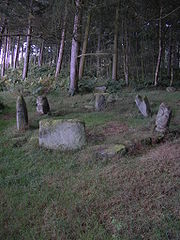
Doll Tor
Encyclopedia

Stone circle
A stone circle is a monument of standing stones arranged in a circle. Such monuments have been constructed across the world throughout history for many different reasons....
near Birchover
Birchover
Birchover is a village and civil parish in the Peak District National Park, in Derbyshire, England. It is about five miles north-west of Matlock, and according to the 2001 UK census had a population of 362...
, west of Stanton Moor
Stanton Moor
Stanton Moor is a small upland area in the Derbyshire Peak District of central and northern England, lying between Matlock and Bakewell near the villages of Birchover and Stanton-in-Peak. It is known for its megaliths and erratics.-Archaeology:...
in the Derbyshire
Derbyshire
Derbyshire is a county in the East Midlands of England. A substantial portion of the Peak District National Park lies within Derbyshire. The northern part of Derbyshire overlaps with the Pennines, a famous chain of hills and mountains. The county contains within its boundary of approx...
Peak District
Peak District
The Peak District is an upland area in central and northern England, lying mainly in northern Derbyshire, but also covering parts of Cheshire, Greater Manchester, Staffordshire, and South and West Yorkshire....
. Dating from the Bronze Age
Bronze Age
The Bronze Age is a period characterized by the use of copper and its alloy bronze as the chief hard materials in the manufacture of some implements and weapons. Chronologically, it stands between the Stone Age and Iron Age...
, the circle consists of six standing stones.
The site was excavated in 1852 by Thomas Bateman
Thomas Bateman
Thomas Bateman was an English antiquary and barrow-digger.-Biography:Thomas Bateman was born in Rowsley, Derbyshire, England, the son of the amateur archaeologist William Bateman...
, and again from 1931 to 1933 by J. P. Heathcote. During this second excavation, three stones were smashed and later repaired with cement
Cement
In the most general sense of the word, a cement is a binder, a substance that sets and hardens independently, and can bind other materials together. The word "cement" traces to the Romans, who used the term opus caementicium to describe masonry resembling modern concrete that was made from crushed...
. In 1993, unknown visitors rearranged the stones to create a more complete but historically inaccurate circle. It was later restored to something close to its original appearance, two fallen stones being re-erected.

